Crossing Platforms In The Arizona Desert: 'Arizona Sunshine' Cross-Platform Co-Op

For most of 2016, Arizona Sunshine, Vertigo Games’ VR zombie apocalypse game, sat on the top of my most wanted list. I was given my first taste of the game back in January during Valve’s Steam VR Developer Showcase, and I’ve been eagerly awaiting its release ever since.
Arizona Sunshine is a first-person zombie apocalypse game set in the Arizona desert. You must scavenge for weapons, ammo, and health and fight your way through countless undead zombies while your search for signs of other survivors. Arizona Sunshine is one of the first AAA titles developed entirely for virtual reality.
The VR market isn’t starving for content. There are over 1000 VR compatible titles on Steam, but most of those games are short experiences. There are a few diamonds in the rough that provide a deep experience, such as Cloudhead Games’ adventure puzzle game, The Gallery, and nDreams’, psychological mystery game, The Assembly. You’ll also find several games that offer hours and hours of replayability, such as I-illusions’ Space Pirate Trainer, and Oculus’ wizard dueling game, The Unspoken. However, VR games that demand you sink many hours to complete are few and far between.
Arizona Sunshine offers more than just a deep experience or hours of replay. It offers both. Not to mention, it’s one of the most polished games that we’ve come across for any VR platform. When Vertigo Games found out we had a Vive and a Rift with Touch controllers, the developer sent us a copy of both versions of the game to evaluate the differences between the two control systems, and to try multiplayer.
Zombies in Your Face
Arizona Sunshine puts you in the heart of the zombie apocalypse like no other game. Vertigo Games built Arizona Sunshine exclusively for room-scale and standing VR setup with hand controls. The game puts you face to face with the undead and tests your reflexes, accuracy, and most importantly, your ability to remain calm under duress.
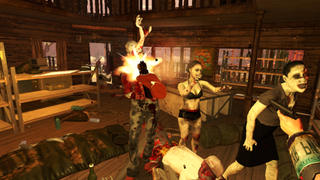
Vertigo Games built several game modes into Arizona Sunshine to keep you busy. The game features an arcade-style wave shooter mode called Horde Mode, which places you in the center of a map with limited ammo and zombies coming from all directions. Horde Mode confines you within your camp, so you must stand your ground and hope for the best.
Horde Mode sends wave after wave of zombies, and you must try to stay alive for as long as you can. After each wave, you’ll find a stash of ammo to get you through the next round. Vertigo Games’ doesn’t supply much ammunition, so it's in your best interest to go for headshots as often as possible.
Stay on the Cutting Edge
Join the experts who read Tom's Hardware for the inside track on enthusiast PC tech news — and have for over 25 years. We'll send breaking news and in-depth reviews of CPUs, GPUs, AI, maker hardware and more straight to your inbox.
Looking For Survivors
Campaign Mode is the meat and potatoes of Arizona Sunshine. Vertigo Games built a highly detailed, beautiful representation of a desert (I’ve never been to Arizona, so I’m not willing to say if it’s accurate or not) environment to explore and scavenge as you look for other people who survived the outbreak.
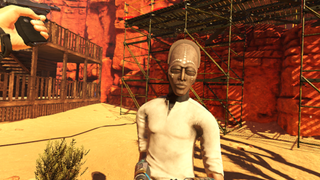
You start the game off with a single pistol, enough ammo to get you by if you have half-decent aim and not much else. Make sure to search all the abandoned vehicles for useful items, such as ammunition and guns. As you progress through the game, you’ll find additional and better weapons.
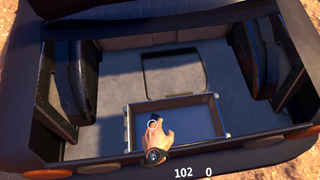
If you’re diligent about searching cars, you won’t have to wait long to find a second pistol to carry around. Don’t swap the original gun for the new one. You can carry up to four weapons on you at any given time. You can hold a gun in each hand, and carry two more in holsters located on your hips. Be aware that you won’t always have access to four slots for weapons. Certain points of the campaign require special items, such as a set of keys, which take up a slot that you must abandon a gun for.
You’ll find space for the rest of your equipment on your belt and person. Your ammo is located on your belt between the two holsters. You can carry ammo for multiple different weapons at once. You’ll also find a place to hold grenades on your chest below your right shoulder. You can hold up to 300 rounds of pistol ammo. I’m not sure how many automatic rounds you can carry and how many shotgun rounds you can hold onto, as I’ve not located enough ammo for either of those guns to fill my belt to capacity.
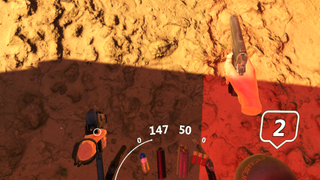
Much of Arizona Sunshine is realistic, but Vertigo Games wasn’t out to build a simulation. In order to allow you to carry two holstered guns and two more in your hands, the developer created a one handed reload system. Press a button on the controller to release the clip and move the gun to your waist to reload it. The reload system doesn’t feel natural, but it’s simple to master, and works well when you’re in a hurry and frantically trying to kill a zombie that’s slashing at you.
Co-Operative Gameplay
Arizona Sunshine also includes two co-operative gameplay modes. Co-operative Campaign mode allows you to play the game’s story mode with a partner. Co-op Horde mode allows up to four players per session.
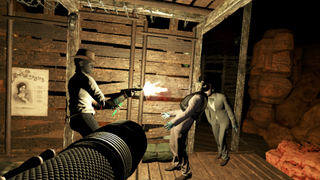
Co-op changes the dynamic of the game. In Horde mode, if you play with a partner, you much be careful with your ammunition. Vertigo Games didn’t increase the number of clips that you get for each wave when more players join. You must share the ammo with your fellow survivalists; otherwise, someone will run out of ammo, and it will be over for all of you. The round ends when one of you dies.
Co-operative campaign mode is a little bit different. In campaign mode, you don’t have to worry about sharing your ammunition with your partner. Each player sees different contents of the ammo box. Guns, on the other hand, aren’t duplicated. If you see a pistol in a car, your partner also sees that same pistol. Remember to leave a few weapons for your buddy to find. Once you pick a gun up, you can’t drop it until you pick up another item to replace it.
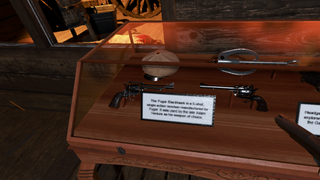
Having to share the guns you find changes the game dynamics. In single player, you can grab every weapon you find without concern. In co-op mode, leaving your partner high and dry means you’ve sealed your own fate. Just like horde mode, you must both survive. Arizona Sunshine doesn’t let you continue to the next checkpoint without your partner. You really must work together to survive.
The change of pace that co-op offers is enough to warrant playing the game solo and then again with a friend. When you play alone, you are responsible for your own survival, and no one is there to hold you back. A partner adds responsibility, and they can hold you back, but having someone to watch your back can be invaluable in a survival situation.
Cross-Platform Multiplayer
If you have a friend with the same VR system as you, setting up a co-op game is simple, but it’s not necessary for both players to buy their games on the same platform. Vertigo Games made it possible to connect gamers on the Oculus platform with gamers on SteamVR. The SteamVR version also supports Touch controllers, but it isn’t necessary to buy the Steam version to play with Vive owners.
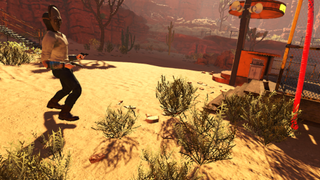
To set up a cross-platform game, both players must launch the same mode of the game. The host creates a match. Subsequent players must select Direct IP and enter the IP address of the host computer.
Thrust That Torso!
Both of our computers were on the same network for our tests, so the connection was instantaneous, but it still took us a few minutes to get started. The delay didn’t stem from a loading issue or connection problem. Laughter is what that slowed us down.

Arizona Sunshine uses a reverse kinetics system to approximate the placement of your character's joints. The game calculates your height and compares the distance of your controllers to work out the animation of your knees, elbows, and hips, but it doesn’t always work properly.
Arizona Sunshine features a calibration process that involves holding your arms out to your sides, bringing them down to your sides, and the pressing the trigger button. If you don’t have your arms stretched all the way down when you pull the trigger, the game will calculate your body all wrong.
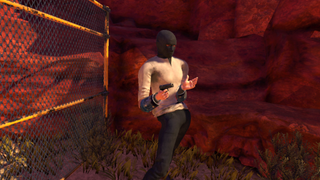
Similarly, if the Oculus calibration has your height wrong or the floor position in SteamVR is off, your character model could appear disfigured. Worse yet, you may find your character standing in a crude pose, such as the one my friend found himself in.
So, Which Hardware Works Better?
Vertigo Games put in a lot of effort to ensure that Arizona Sunshine works well with the HTC Vive and the Oculus Rift with Touch, but there are significant differences between the two controls schemes.
When you play Arizona Sunshine with an HTC Vive, you navigate around the map via teleportation. The teleport mechanic is like the Blink system, but it doesn’t allow you to change orientation like Blink does. Vertigo Games chose to use the menu button located above the touchpad on the Vive controllers as the teleport button. Blink requires the Touchpad so that you can use your thumb to change orientation before moving. Vive expects players to turn their bodies the direction they wish to travel.
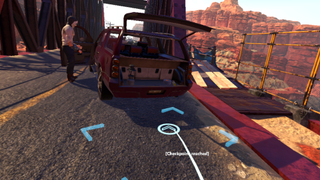
The use of the menu button for teleportation is somewhat awkward. Almost every other game that employs a teleport system relies on the touchpad to activate the movement. The odd choice of teleport button becomes even more perplexing after playing the Oculus version of the game, which offers the full Blink mechanic.
When you play Arizona Sunshine with Oculus Touch controllers, you use Blink to move around. Vertigo Games mapped the teleport system to the thumbstick, which lets you reorient as you teleport from spot to spot. You can also use the thumbstick to snap rotate without teleporting. Vertigo Games built the Oculus version of the game for 2-sensor standing configurations, so you aren’t expected to turn your body. The mechanics don’t change if you add a third sensor for room-scale tracking.
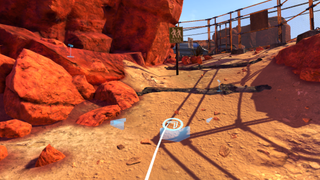
It’s hard to say which configuration works better. The SteamVR version gives you full freedom to turn around in all directions naturally, but it limits the versatility of the teleport system. On the other hand, the Oculus version doesn’t limit the teleport mechanic, but I found it easy to get physically turned away from the sensors due to my natural inclination to turn my body in reaction to an attack. I often had to peek at my surroundings to reposition myself facing my sensors.
VR Let’s You Do Things That Aren’t Possible In Traditional Games
It’s no secret that I’m a proponent for VR. It’s also not a secret that I’ve spent quite a bit of time testing and playing a wide variety of games in VR. I thought I had considered most of the subtle things that virtual reality games offer that a traditional game can’t. Things like the peeking your head around a corner, or crouching behind a short wall and peeking your eyes ever so slightly over it to catch a glimpse of the action on the other side.
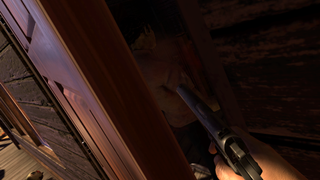
At one point in the campaign, you’ll reach an old cottage associated with the local mine. On the upper floor, I found myself on the opposite side of a door from two ambling zombies. In a traditional game, you’d have one choice: Open the door and shoot the zombies while trying not to get hit. In VR, you have another option. I decided to crack the door open just enough to reach the barrel of the gun in and pop them off one by one. The zombies didn’t have a chance to get to me, and I was overwhelmed with excitement over the profound realization of this possibility. This moment proved to me that we’re just starting to scratch the surface of what you can do in VR.
Conclusion
Vertigo Games put a lot of effort into creating something special. It’s not a perfect game, but it’s one of the best examples of a high-budget VR property. Arizona Sunshine sits in a class that few other virtual reality games have managed to achieve.
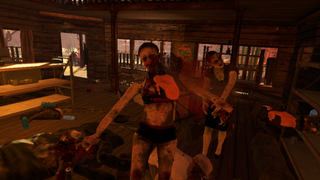
The release of Arizona Sunshine was fraught with negative attitudes towards Vertigo Games for it’s perceived attempt at locking part of the game down to certain hardware configurations. We plan to explore the performance claims of the developer to determine if a new i7 processor is necessary for the advanced features, but we don’t think that should have much bearing on your decision to buy Arizona Sunshine.
Vertigo Games put together an excellent game that operates fine on minimum VR specification hardware. You shouldn’t let the lack of a few advanced physics features hold you back from experiencing this game.
Kevin Carbotte is a contributing writer for Tom's Hardware who primarily covers VR and AR hardware. He has been writing for us for more than four years.
-
Jeff Fx It's not really cross-platform gaming, and shouldn't be news. The Rift and the Vive operate on the same platform, and just use different displays. It's like being able to play a PC game on your Viewsonic monitor with someone who has Dell monitor. It's just expected. It should be news when a multiplayer game is segregated by display device.Reply
>The host creates a match. Subsequent players must select Direct IP and enter the IP address of the host computer.
That sounds like total incompetence. You should be able to pick from your friends list with the software finding the correct IP, just like with any PC game. -
Jeff Fx Reply19028994 said:It's a really awesome game, hope the Core i7 thing didn't scare people away.
It is a great game, but I have seen some troubled people who are unable to get past the i7 thing. Once an entitled blockhead throws a tantrum, it's hard to talk them down so they can function again. -
kcarbotte Reply19029127 said:It's not really cross-platform gaming, and shouldn't be news. The Rift and the Vive operate on the same platform, and just use different displays. It's like being able to play a PC game on your Viewsonic monitor with someone who has Dell monitor. It's just expected. It should be news when a multiplayer game is segregated by display device.
>The host creates a match. Subsequent players must select Direct IP and enter the IP address of the host computer.
That sounds like total incompetence. You should be able to pick from your friends list with the software finding the correct IP, just like with any PC game.
The Oculus software platform is not compatible with Steam's software platform. It has nothing to do with the hardware.
If both players are on Steam, or both players on Oculus, the friends list idea works.
The direct IP connection allows for connection between the two software platforms. A couple other games have cross platform play, such as Eve Valkyrie, Eagle Flight, and Warewolves Within. Most games do not work between the two.
-
wifiburger another zombie game, this time VR ! well ok i'll pass since you know once you play one zombie game you don't really need to play another one,Reply
lucky for me the zombie game was "the last of us" so that was awesome :-) -
Sakkura Reply19048119 said:another zombie game, this time VR ! well ok i'll pass since you know once you play one zombie game you don't really need to play another one,
lucky for me the zombie game was "the last of us" so that was awesome :-)
It's a very different experience in VR.
Most Popular

